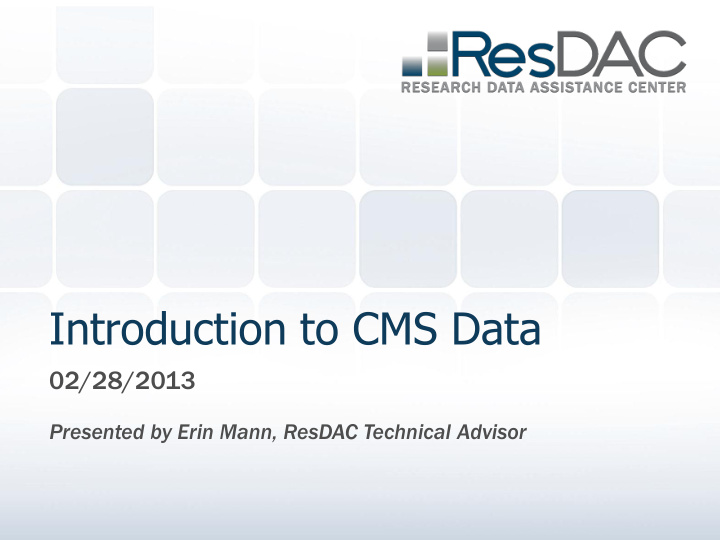



Introduction to CMS Data 02/28/2013 Presented by Erin Mann, ResDAC Technical Advisor
About ResDAC Centers for Medicare and Medicaid (CMS) contractor Offer free assistance to researchers interested in using Medicare and Medicaid data for research Staffed by a team of public health and health services research specialists Provide a range of services related to CMS data ˗ Assistance Desk ˗ Workshops and Outreach 2
CMS Data – Where to Start? Nearly 100 data files that can be requested or downloaded Many other resources on the CMS website including summary statistics, reports, and payment system methodology files Often difficult for both new and seasoned CMS data users to know where to start ResDAC is here re to help. p. 3
Overview of CMS Data Files Goals for today ˗ Provide an overview of how data files are classified ˗ Requirements for release ˗ Examples of data files ˗ Information about accessing data files More detailed information about data file contents will be presented at later webinars 4
CMS Data File Privacy Levels All CMS data files are organized into three privacy levels. ˗ Non-identifiable or Public Use (PUF) ˗ Limited Data Sets (LDS) ˗ Research Identifiable (RIF) 5
Non-Identifiable Data What are non-identifiable files? Also known as Public Use Files (PUFs) Files have been edited and stripped of all information that could be used to identify beneficiaries The files contain aggregate level data on Medicare beneficiary or provider utilization Some files contain no utilization information, but include characteristics about providers 6
Non-Identifiable Data What are examples of non-identifiable data? Provider of Services File ˗ Information about institutional providers ˗ Name, facility characteristics Part B Summary Files ˗ Organized by procedure code ˗ Total procedures billed, payment amounts Medicare Cost Reports ˗ Annual reports submitted to CMS ˗ Utilization statistics, costs, charges, financial information 7
Non-Identifiable Data How can I access non-identifiable data? Access will depend on the file, but data can either be downloaded for free from the CMS website OR purchased and the data will be sent on hard media Non-identifiable data can also be shared No data use agreement is required 8
Limited Data Sets (LDS) What are LDS files? LDS data contain beneficiary level data Files include protected health information, but selected variables have been removed, encrypted, or ranged ˗ No zip code, only state or county ˗ No exact DOB, either age year of 5-year range ˗ No true physician identifiers; institutional facilities CAN be identified Only available as standard extracts ˗ 5% random sample or 100% files (depends on file) ˗ Not possible to customize based on geography, diagnosis/procedures codes, or researcher-submitted identifiers (Medicare numbers, SSNs for known cohort) 9
Limited Data Sets (LDS) What are examples of LDS files? Standard Analytic Files (SAFs) ˗ Fee-for-service claims data ˗ Files organized by utilization type Denominator File ˗ Demographic and enrollment information ˗ Often used with the SAFs MedPAR ˗ Separate files for hospital, SNF, and LTCH ˗ Cannot be linked to the SAFs Medicare Current Beneficiary Survey (MCBS) 10
Limited Data Sets (LDS) How can I access LDS files? Requestors must submit an application to establish a Data Use Agreement (DUA) ˗ New Use – purchase the data new ˗ Reuse – request to use data already at your organization for a new purpose Applications involve 4 documents Requests typically take up to 8 weeks to process Wide range of data uses 11
Research Identifiable Files (RIF) What are RIFs? RIF data contain beneficiary level protected health information ˗ Most RIF data files do not contain direct identifiers, but do include information such as zip code, date of birth, and exact dates of service Data is at the beneficiary level Standard extracts are available (5% random sample), but custom cohorts (diabetics in Minnesota) are also possible 12
Research Identifiable Files (RIF) What are examples of RIFs? Medicare Data ˗ Fee-for-service claims data ˗ MedPAR ˗ Part D event data ˗ Assessment data ˗ Master Beneficiary Summary File Medicaid Data ˗ MAX Files 13
Research Identifiable Files (RIF) How can I access RIF data? RIF data are only released for research studies Requestors must submit an application to establish a Data Use Agreement ˗ New Use – purchase the data new ˗ Reuse – request to use data already at your organization for a new study Packets typically involve at least 8 documents and documents are reviewed by ResDAC prior to submission to CMS RIF requests are reviewed by the CMS Privacy Board 14
Summary of Privacy Level Differences RIF LDS Non-identifiable Beneficiary Yes Yes No level data? Data files Yes No No customizable to specific cohort? Linkable to Yes No No non-CMS data at the beneficiary level? Require Privacy Yes No No Board Review? Require a DUA Yes Yes No 15
New File Series: DE-SynPUFs Data Entrepreneurs' Synthetic Public Use Files Series of linkable files that were released in February File is classified as a PUF since the data is synthetic, but created from LDS files Purposes of the DE-SynPUF: Allow data entrepreneurs to develop and create software ˗ and applications Train researchers on data complexities prior to accessing ˗ actual CMS data ˗ Support data mining while preserving beneficiary privacy 16
Resources for Help ResDAC Assistance Desk ˗ Email: resdac@umn.edu ˗ Phone: 1-888-973-7322 ˗ Web: http://www.resdac.org ResDAC Website ˗ Search for files by Privacy Level ˗ Access request materials for RIF requests ˗ Browse ResDAC KnowledgeBase 17
Resources for Help CMS Website - Good resource for Non-identifiable and LDS files - CMS.gov Research, Statistics, Data and Systems Files for Order - ResDAC website is more appropriate for RIF data CMS Data Navigator ˗ http://dnav.cms.gov ˗ Menu-driven search tool for locating CMS data and information resources 18
Upcoming Webinars 03/19 – Non-Identifiable Data 04/04 – Cost Reports 04/09 - DE-SynPUFs 04/10 – Limited Data Sets 04/25 – Research Identifiable Data 05/02 – Utilization Data 19
Recommend
More recommend